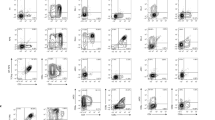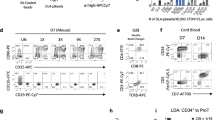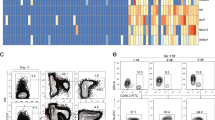Abstract
Induced pluripotent stem cells (iPSCs) have become important cell sources for genetic disease models, and they have the potential to be cell sources for future clinical therapies. However, invasive tissue sampling reduces the number of candidates who consent to donate cells for iPSC generation. In addition, integrated transgenes can potentially insert at inappropriate points in the genome, and in turn have a direct oncogenic effect. Technical modifications using a combination of activated T cells and a temperature-sensitive mutant of Sendai virus (SeV) can avoid invasive tissue sampling and residual transgene issues in generating iPSCs. Such advances may increase the number of consenting patients for cell donations. Here we present a detailed protocol for the generation of iPSCs from a small amount of human peripheral blood using a combination of activated T cells and mutant SeV encoding human OCT3/4, SOX2, KLF4 and c-MYC; T cell–derived iPSCs can be generated within 1 month of blood sampling.
This is a preview of subscription content, access via your institution
Access options
Subscribe to this journal
Receive 12 print issues and online access
$259.00 per year
only $21.58 per issue
Buy this article
- Purchase on Springer Link
- Instant access to full article PDF
Prices may be subject to local taxes which are calculated during checkout




Similar content being viewed by others
References
Takahashi, K. & Yamanaka, S. Induction of pluripotent stem cells from mouse embryonic and adult fibroblast cultures by defined factors. Cell 126, 663–676 (2006).
Takahashi, K., Okita, K., Nakagawa, M. & Yamanaka, S. Induction of pluripotent stem cells from fibroblast cultures. Nat. Protoc. 2, 3081–3089 (2007).
Takahashi, K. et al. Induction of pluripotent stem cells from adult human fibroblasts by defined factors. Cell 131, 861–872 (2007).
Aasen, T. et al. Efficient and rapid generation of induced pluripotent stem cells from human keratinocytes. Nat. Biotechnol. 26, 1276–1284 (2008).
Kim, J.B. et al. Direct reprogramming of human neural stem cells by OCT4. Nature 461, 649–653 (2009).
Loh, Y.H. et al. Generation of induced pluripotent stem cells from human blood. Blood 113, 5476–5479 (2009).
Seki, T. et al. Generation of induced pluripotent stem cells from human terminally differentiated circulating T cells. Cell Stem Cell 7, 11–14 (2010).
Fusaki, N., Ban, H., Nishiyama, A., Saeki, K. & Hasegawa, M. Efficient induction of transgene-free human pluripotent stem cells using a vector based on Sendai virus, an RNA virus that does not integrate into the host genome. Proc. Jpn. Acad. Ser. B Phys. Biol. Sci. 85, 348–362 (2009).
Li, H.O. et al. A cytoplasmic RNA vector derived from nontransmissible Sendai virus with efficient gene transfer and expression. J. Virol. 74, 6564–6569 (2000).
Ban, H. et al. Efficient generation of transgene-free human induced pluripotent stem cells (iPSCs) by temperature-sensitive Sendai virus vectors. Proc. Natl. Acad. Sci. USA 108, 14234–14239 (2011).
Desai-Mehta, A., Lu, L., Ramsey-Goldman, R. & Datta, S.K. Hyperexpression of CD40 ligand by B and T cells in human lupus and its role in pathogenic autoantibody production. J. Clin. Invest. 97, 2063–2073 (1996).
Eminli, S. et al. Differentiation stage determines potential of hematopoietic cells for reprogramming into induced pluripotent stem cells. Nat. Genet. 41, 968–976 (2009).
Hong, H. et al. Suppression of induced pluripotent stem cell generation by the p53-p21 pathway. Nature 460, 1132–1135 (2009).
Okano, S. et al. Recombinant Sendai virus vectors for activated T lymphocytes. Gene Ther. 10, 1381–1391 (2003).
Brown, M.E. et al. Derivation of induced pluripotent stem cells from human peripheral blood T lymphocytes. PLoS ONE 5, e11373 (2010).
Loh, Y.H. et al. Reprogramming of T cells from human peripheral blood. Cell Stem Cell 7, 15–19 (2010).
Staerk, J. et al. Reprogramming of human peripheral blood cells to induced pluripotent stem cells. Cell Stem Cell 7, 20–24 (2010).
Aasen, T. & Belmonte, J.C. Isolation and cultivation of human keratinocytes from skin or plucked hair for the generation of induced pluripotent stem cells. Nat. Protoc. 5, 371–382 (2010).
Yan, X. et al. iPS cells reprogrammed from human mesenchymal-like stem/progenitor cells of dental tissue origin. Stem Cells Dev. 19, 469–480 (2010).
Smith-Garvin, J.E., Koretzky, G.A. & Jordan, M.S. T cell activation. Annu. Rev. Immunol. 27, 591–619 (2009).
Lan, R.Y., Selmi, C. & Gershwin, M.E. The regulatory, inflammatory, and T cell programming roles of interleukin-2 (IL-2). J. Autoimmun. 31, 7–12 (2008).
Acknowledgements
T.S. is a research fellow of the Japan Society for the Promotion of Science. This work was supported in part by research grants from the Ministry of Education, Science and Culture, Japan, and by a grant from the New Energy and Industrial Technology Development Organization.
Author information
Authors and Affiliations
Contributions
T.S. and S.Y. prepared most of the paper. K.F. provided advice and proofread the paper.
Corresponding authors
Ethics declarations
Competing interests
The authors declare no competing financial interests.
Rights and permissions
About this article
Cite this article
Seki, T., Yuasa, S. & Fukuda, K. Generation of induced pluripotent stem cells from a small amount of human peripheral blood using a combination of activated T cells and Sendai virus. Nat Protoc 7, 718–728 (2012). https://doi.org/10.1038/nprot.2012.015
Published:
Issue Date:
DOI: https://doi.org/10.1038/nprot.2012.015
This article is cited by
-
Modular deep learning enables automated identification of monoclonal cell lines
Nature Machine Intelligence (2021)
-
The therapeutic potential of multiclonal tumoricidal T cells derived from tumor infiltrating lymphocyte-derived iPS cells
Communications Biology (2021)
-
Variation in RARG increases susceptibility to doxorubicin-induced cardiotoxicity in patient specific induced pluripotent stem cell-derived cardiomyocytes
Scientific Reports (2020)
-
Function and Immunogenicity of Gene-corrected iPSC-derived Hepatocyte-Like Cells in Restoring Low Density Lipoprotein Uptake in Homozygous Familial Hypercholesterolemia
Scientific Reports (2019)
-
A six-inhibitor culture medium for improving naïve-type pluripotency of porcine pluripotent stem cells
Cell Death Discovery (2019)
Comments
By submitting a comment you agree to abide by our Terms and Community Guidelines. If you find something abusive or that does not comply with our terms or guidelines please flag it as inappropriate.



